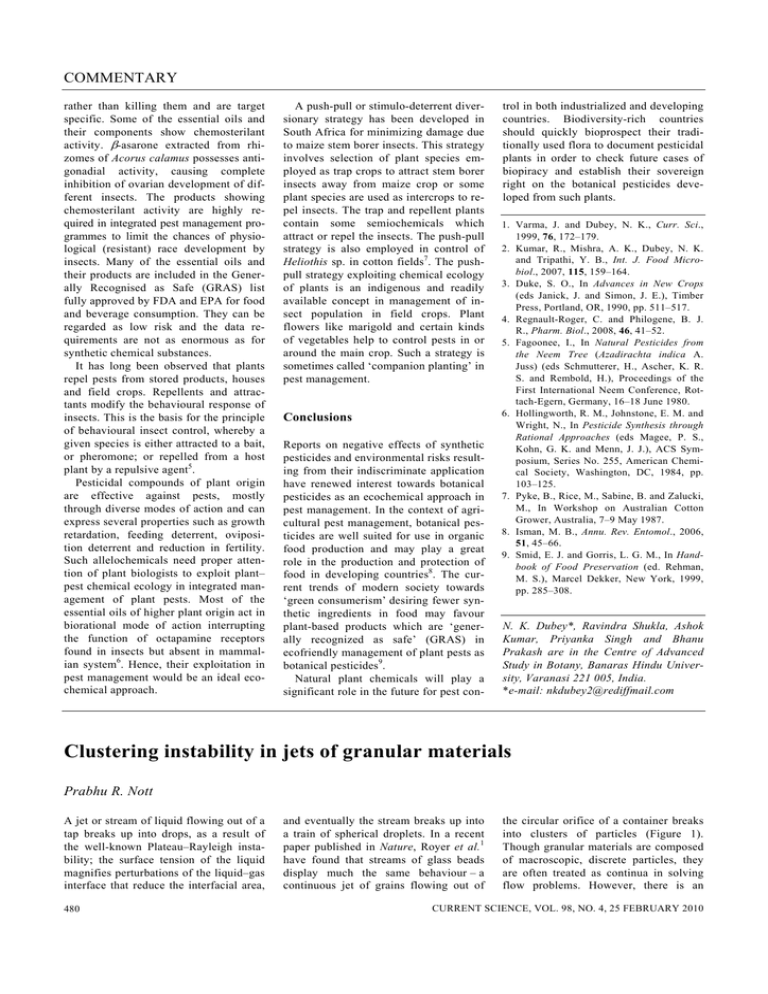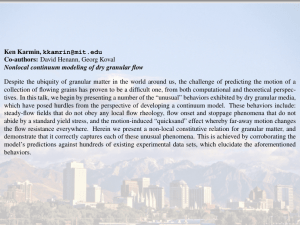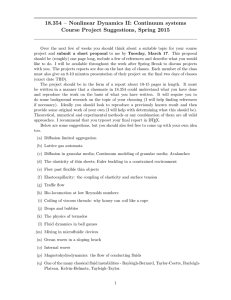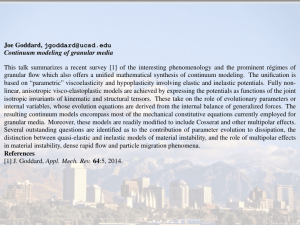COMMENTARY
advertisement

COMMENTARY rather than killing them and are target specific. Some of the essential oils and their components show chemosterilant activity. β-asarone extracted from rhizomes of Acorus calamus possesses antigonadial activity, causing complete inhibition of ovarian development of different insects. The products showing chemosterilant activity are highly required in integrated pest management programmes to limit the chances of physiological (resistant) race development by insects. Many of the essential oils and their products are included in the Generally Recognised as Safe (GRAS) list fully approved by FDA and EPA for food and beverage consumption. They can be regarded as low risk and the data requirements are not as enormous as for synthetic chemical substances. It has long been observed that plants repel pests from stored products, houses and field crops. Repellents and attractants modify the behavioural response of insects. This is the basis for the principle of behavioural insect control, whereby a given species is either attracted to a bait, or pheromone; or repelled from a host plant by a repulsive agent5. Pesticidal compounds of plant origin are effective against pests, mostly through diverse modes of action and can express several properties such as growth retardation, feeding deterrent, oviposition deterrent and reduction in fertility. Such allelochemicals need proper attention of plant biologists to exploit plant– pest chemical ecology in integrated management of plant pests. Most of the essential oils of higher plant origin act in biorational mode of action interrupting the function of octapamine receptors found in insects but absent in mammalian system6. Hence, their exploitation in pest management would be an ideal ecochemical approach. A push-pull or stimulo-deterrent diversionary strategy has been developed in South Africa for minimizing damage due to maize stem borer insects. This strategy involves selection of plant species employed as trap crops to attract stem borer insects away from maize crop or some plant species are used as intercrops to repel insects. The trap and repellent plants contain some semiochemicals which attract or repel the insects. The push-pull strategy is also employed in control of Heliothis sp. in cotton fields7. The pushpull strategy exploiting chemical ecology of plants is an indigenous and readily available concept in management of insect population in field crops. Plant flowers like marigold and certain kinds of vegetables help to control pests in or around the main crop. Such a strategy is sometimes called ‘companion planting’ in pest management. Conclusions Reports on negative effects of synthetic pesticides and environmental risks resulting from their indiscriminate application have renewed interest towards botanical pesticides as an ecochemical approach in pest management. In the context of agricultural pest management, botanical pesticides are well suited for use in organic food production and may play a great role in the production and protection of food in developing countries8. The current trends of modern society towards ‘green consumerism’ desiring fewer synthetic ingredients in food may favour plant-based products which are ‘generally recognized as safe’ (GRAS) in ecofriendly management of plant pests as botanical pesticides9. Natural plant chemicals will play a significant role in the future for pest con- trol in both industrialized and developing countries. Biodiversity-rich countries should quickly bioprospect their traditionally used flora to document pesticidal plants in order to check future cases of biopiracy and establish their sovereign right on the botanical pesticides developed from such plants. 1. Varma, J. and Dubey, N. K., Curr. Sci., 1999, 76, 172–179. 2. Kumar, R., Mishra, A. K., Dubey, N. K. and Tripathi, Y. B., Int. J. Food Microbiol., 2007, 115, 159–164. 3. Duke, S. O., In Advances in New Crops (eds Janick, J. and Simon, J. E.), Timber Press, Portland, OR, 1990, pp. 511–517. 4. Regnault-Roger, C. and Philogene, B. J. R., Pharm. Biol., 2008, 46, 41–52. 5. Fagoonee, I., In Natural Pesticides from the Neem Tree (Azadirachta indica A. Juss) (eds Schmutterer, H., Ascher, K. R. S. and Rembold, H.), Proceedings of the First International Neem Conference, Rottach-Egern, Germany, 16–18 June 1980. 6. Hollingworth, R. M., Johnstone, E. M. and Wright, N., In Pesticide Synthesis through Rational Approaches (eds Magee, P. S., Kohn, G. K. and Menn, J. J.), ACS Symposium, Series No. 255, American Chemical Society, Washington, DC, 1984, pp. 103–125. 7. Pyke, B., Rice, M., Sabine, B. and Zalucki, M., In Workshop on Australian Cotton Grower, Australia, 7–9 May 1987. 8. Isman, M. B., Annu. Rev. Entomol., 2006, 51, 45–66. 9. Smid, E. J. and Gorris, L. G. M., In Handbook of Food Preservation (ed. Rehman, M. S.), Marcel Dekker, New York, 1999, pp. 285–308. N. K. Dubey*, Ravindra Shukla, Ashok Kumar, Priyanka Singh and Bhanu Prakash are in the Centre of Advanced Study in Botany, Banaras Hindu University, Varanasi 221 005, India. *e-mail: nkdubey2@rediffmail.com Clustering instability in jets of granular materials Prabhu R. Nott A jet or stream of liquid flowing out of a tap breaks up into drops, as a result of the well-known Plateau–Rayleigh instability; the surface tension of the liquid magnifies perturbations of the liquid–gas interface that reduce the interfacial area, 480 and eventually the stream breaks up into a train of spherical droplets. In a recent paper published in Nature, Royer et al.1 have found that streams of glass beads display much the same behaviour – a continuous jet of grains flowing out of the circular orifice of a container breaks into clusters of particles (Figure 1). Though granular materials are composed of macroscopic, discrete particles, they are often treated as continua in solving flow problems. However, there is an CURRENT SCIENCE, VOL. 98, NO. 4, 25 FEBRUARY 2010 COMMENTARY Figure 1. Images of a jet of glass beads (a–d) and a jet of copper beads (e–h) at different distances (increasing from left to right) from the circular orifice of the container. Panels (a), (e) are at the orifice, and panels (d), (h) are 97 cm below. Reprinted by permission from Macmillan Publishers Ltd: Nature, 459, 1110–1113 (2009), copyright (2009). important difference between liquids and granular materials: the former has finite surface tension, whereas granular materials composed of large particles are thought to have no surface tension, due to the absence of an attractive force between the grains. Indeed, the classical picture of bubbling in gas-fluidized beds is that gas bubbles rise in a medium of zero surface tension (and zero viscosity)2. (Royer et al. appear to be unaware of these decades-old studies, and credit recent publications of their own group for the hypothesis that granular materials behave as fluids of zero surface tension.) The obvious question then is what causes the breakup of granular jets into clusters? To answer this question, Royer et al. have conducted a thorough experimental investigation. To study the evolution of the clusters, they have conducted Lagrangian imaging of a small section of the jet with a video camera that falls freely under gravity. This is supple- mented by atomic force microscopy (AFM) to measure the cohesive forces between individual grains, and scanning electron microscopy (SEM) to study the topography of the grain surface. They have studied jets of glass and copper beads, with and without certain coatings, to understand the cause of clustering. Based on these measurements, Royer et al.1 conclude that cluster formation is driven by ‘minute, nano-Newton cohesive forces that arise from van der Waal’s interactions and capillary bridges between nanometer-scale surface asperities’. In other words, the surface tension of the granular material is not zero, but very small, as a result of the minute attractive forces between the grains. The implication is that the very small surface tension is enough to trigger the Plateau–Rayleigh instability in a granular jet. A fair degree of experimental ingenuity is evident from the article. Though the breakup of granular streams and jets has CURRENT SCIENCE, VOL. 98, NO. 4, 25 FEBRUARY 2010 been reported in previous studies, Royer et al. have studied it in detail using highspeed imaging. The additives used to alter the surface of the particles, and the characterization of particle interactions by AFM and SEM provoke interesting questions on the reasons for clustering. However, the article is seriously deficient in analysis of the data. The explanations presented for the mechanism of clustering are self-contradictory and confusing, leaving one deeply doubtful of their conclusions. This is elaborated below. The authors report that adding a small quantity of Aerosil (fine silica nanoparticles of diameter 1–100 nm) to glass beads of 151 μm diameter prevents cluster formation. Their SEM image shows the Aerosil particles forming nano-asperities on the beads. They conclude that the nano-asperities reduce the attractive van der Waal’s force of attraction, thereby reducing clustering. However, Aerosil does not prevent clustering in jets of glass beads of diameter 107 μm and 54 μm, a point that is mentioned in passing (in a figure caption), with no explanation. How can the ‘local, nanometerscale grain topography’, which is claimed to determine the strength of the attractive force, differ so much between macroscopic glass beads of different sizes? Moreover, if it is only the nanometerscale topography that determines the attractive force, how do the nanometersize asperities formed by the Aerosil particles reduce the force? The Hamaker constant, which determines the van der Waal’s attraction, is likely to be similar in magnitude for glass and Aerosil, as the former too is mostly silica. Their argument for why copper grains do not cluster, despite their cohesive force being greater than for glass beads, is equally unconvincing. They state that the ‘pronounced large-scale roughness for copper is likely to reduce sliding, leading to different rotational collision dynamics’. This is a puzzling explanation, to say the least. Collision dynamics has not been invoked to explain the clustering of glass beads – indeed, they have argued that collision inelasticity is not responsible for clustering. Moreover, friction is a dissipative mechanism and will decrease relative motion; one expects that this should aid clustering. The explanation offered in the supplementary section on the effect of grain roughness – that it leads to an increase in the granular temperature, which slows inelastic cool481 COMMENTARY ing – adds to the confusion. Firstly, the mechanism proposed for the increased granular temperature is dubious, and secondly it contradicts their observation that increasing inelasticity (which will hasten inelastic cooling) reduces clustering. Perhaps the most telling deficiency in their analysis is the following: Rayleigh’s stability analysis shows that the fastest growing instability has a growth rate ω = 0.34 (σ/ρR3)1/2, where ρ and σ are the density and surface tension, and R is the radius of the orifice. From the cohesive force measured by AFM, Royer et al.1 extract a surface tension of ~10–7 N/m. Using a particle density of 2700 kg/m3 and volume fraction of 0.4, 482 the time scale one gets for development of the instability is 1/ ω ≈ 27 s, which is about two orders of magnitude larger than the ≈0.4 s observed in the experiments. This discrepancy appears to have gone unnoticed. In the end, none of the explanations given for clustering or its absence appear to have merit. Although the experimental investigations provoke interesting questions on the stability of granular jets, the level of analysis is below par. This author’s disappointment in this regard is heightened by the final sentence, ‘Given that freely falling granular streams are exquisitely sensitive probes for minute forces they also provide a new tool with which to measure cohesive energies in granular systems’ – setting aside the fact that their data do not support the assertion of exquisite sensitivity, one would hardly use a granular jet to probe cohesive energies, when more reliable and accurate tools such as the AFM are easily available. 1. Royer, J. R. et al., Nature, 2009, 459, 1110–1113. 2. Jackson, R., Trans. Inst. Chem. Eng., 1963, 41, 22–28. Prabhu R. Nott is in the Department of Chemical Engineering, Indian Institute of Science, Bangalore 560 012, India. e-mail: prnott@chemeng.iisc.ernet.in CURRENT SCIENCE, VOL. 98, NO. 4, 25 FEBRUARY 2010




